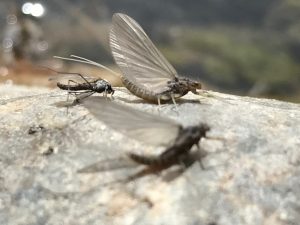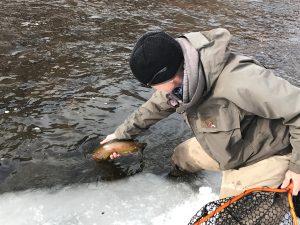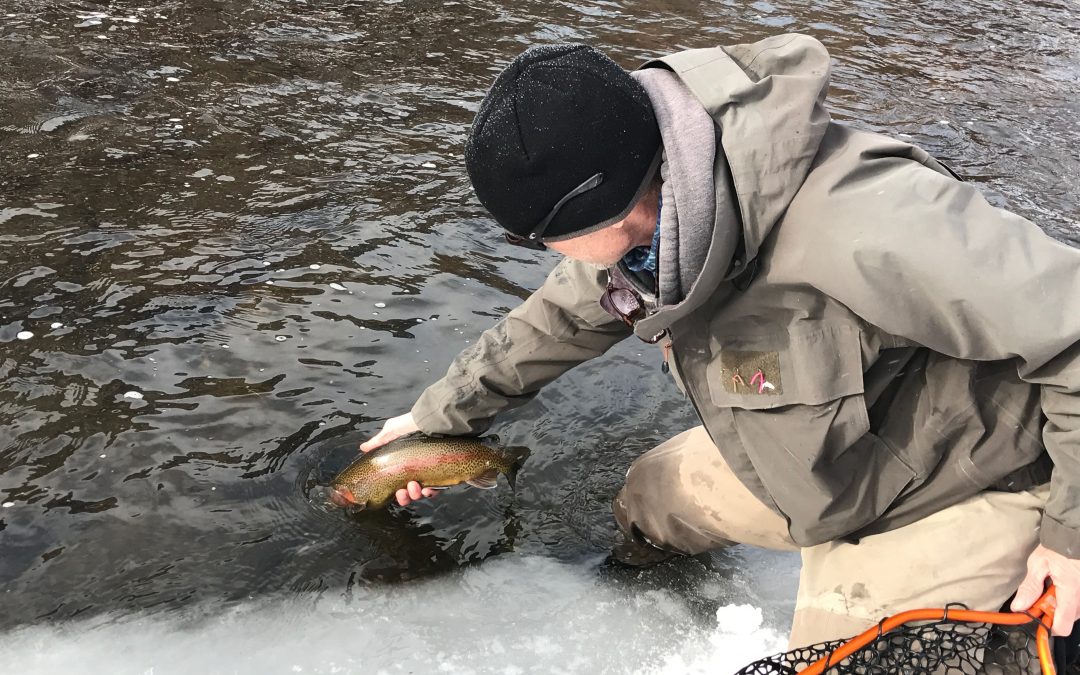Winter Troutcapades
Michael Salomone -Echo Ambassador
Suspended in frigid air, my fly line stops shooting through the guides. Ice grips hold of the new Airflo line locking it up tight in the tip of my Echo Trout rod. It’s early, the skies are clear blue but I’m still standing in the shade. There is enough of a temperature hold on the morning’s warming sun to keep me in ice. But that is soon to change during a day of winter fly fishing in Colorado.
The late morning shadows that hold the cold are formed by thick stands of riverbank trees, tall cliffs or bridge supports. Whatever it is, the temperature rises slower during the morning in shaded areas. And until the sun begins to work its magic, the increase in bug activity will hold off as well.
Midday warmth spurred by direct sunlight unlocks the door to insect activity. Midges start popping up and skate across the surface. The tiny insects buzzing on the river surface immitate bumper cars at the carnival. The midges stumble onto the ice and crawl over the crystal covered riverbank snow. Appearing as black dots on white snow closer inspection gives anglers an edge in determining the size of your flies. Their miniscule size disappears into the air when they take flight.

On blue sky days, Colorado riverwater has accumulated enough warmth from the morning sunshine to trigger a mid winter Blue Wing Olive emergence. It takes the extra warmth from a full day of direct winter sunlight to activate the hatch. Mayflies like BWOs hover and rise lazily into the air during the winter months. Silhouetted against dark shadowed areas insects are easily identified from a distance. Flying at a slow speeds their wings seem to struggle lifting the bug with any altitude.
The extent of wintertime insect activity revolves solely around these two insects, Midges and Blue Wing Olives predominatly midges. However large trout need a food source that replenishes depleted reserves and that means meat. Streamers mimic large offerings that big trout need to survive winter. Preparing for spawning activity causes mature trout to bulk up before the show. Big rainbows are often caught in the winter months on large slow stripped streamers. Heavy weights in large streamers keep the fly close to the bottom of the river. Eliminating the need for trout to chase the offering and increasing hookups.
Low and slow is the best description for how to present a wintertime streamer. Trout do not have the energy to pursue a fly any distance. A streamer fly dead drifted through a rocky run or at the end of a shallow riffle covers the prime areas for streamer-eating trout. Downstream of riffles where the river depth drops off into deeper holding water is another great place to present a midwinter streamer.

When it comes to winter fly fishing gear, anglers need to think about safety as a first priority. Felt-bottomed boots accumulate snow and ice rapidly with each snowbound step. However, rubber soled boots allow for the addition of studs or cleats providing a surefooted approach on the ice and frozen river bottom. Rocks that acquired a smothering vegetation growth in the fall develop a slick surface in the winter as the plants decay in the cold.
Understanding that slips are inevitable is a good approach so you prepare yourself for how you are going to fall. Fighting to regain balance on the ice is a recipe for a busted elbow. The angler anticipating a fall at some point releases their tight grip, accepts the tumble and falls gracefully without injury. Wading staffs are often overlooked but aid tremendously in balancing on the ice and in the river.
Hand warmers extend the amount of time an angler can withstand the ever-present wind after hands are submerged. Keeping them in your jacket pocket allows easy quick access for fingers and helps warm your core at the same time. Hats are a necessity. The addition of a neck-warming buff shuns off the frigid cold.
Sunglasses provide double duty for winterbound anglers. The water is extremely clear and low making trout especially spooky. Polarized sunglasses allow fly fishers the ability to see trout in less than ideal conditions. While you may not be able to decipher the actual fish, the shadow they cast beneath is unmistakeable. No amount of camouflage can mask the shadow caused by the sun. Sunglasses also provide eye protection. We are swinging hooks through the air.
In the winter, the durabiility of your rods and reels is the key to success. Click and pawl reels will freeze up preventing retrieval or release of your fly line when needed. Sealed drag reels, while slightly more expensive, are the tools of choice for winter fly fishing.

Echo is at the top of the game when it comes down to winter fly rods. The inexpensive Base provides a perfect platform for winter fly fishing and a back up rod any angler would be happy to slide in their quiver. Stepping up slightly in price is my personal favorite for the winter the Carbon XL. At a price point all anglers can appreciate the Carbon XL performs way above its class.
With a stiff no-nonsense backbone and forgiving tip, the new Echo Trout rod delivers flawlessly in the cold. Replacing the very popular E3 series the Echo Trout rod is going to bring smiles to angler’s faces everwhere. Possessing the ability to turnover heavy nymph rigs as well as a soft touch to present small dry flies when the hatch starts the new Echo Trout rod will impress you.
The finish on the Echo Trout rod is inconspicuous. No flashy, shiny surfaces to reflect light and spook wary trout. The grip accomodates a variety of angling styles and hand positions enhancing the ability of the angler to present a fly accurately and efficiently. Attractive blue wraps accent the guides elevating the face value in this series of rods. Available in the comfortable and familiar 9’ length in 4, 5 & 6wts there is a 9’6” 6wt to help deal with strong winds and chunky flies. An 8’4” 4wt rounds out the Trout models and is going to fit nicely in smaller creeks when the snow melts.
For the price of an average movie ticket and a box of popcorn you can upgrade from the Echo Carbon XL to the Echo Ion XL. The Ion is available in 6-10wt with the 9’length and 5-8wt in a 10’ model. The additional foot of rod gives anglers enhanced line management ability, a desireable characteristic when fly fishing from a boat. The added length is welcomed in winter for reaching out during the fight when a trout tries to sever your light tippet on the shelf ice.
Workhorse rods are the preference for winter fly fishing. Conditions are harsh and falls inevitable so durability is a key feature. Echo rods excel when it comes to toughness. “Hammers” is a term I use for the Echo rods my client use. Exposed to the wear and tear day to day guiding presents and the extreme conditions of winter fly fishing my “hammers” hold up.
Michael Salomone
Sal.
website:
Instagram:
mikesalomone88
Vail Valley Anglers
Fly Fishing Guide & Content Writer

Recent Comments